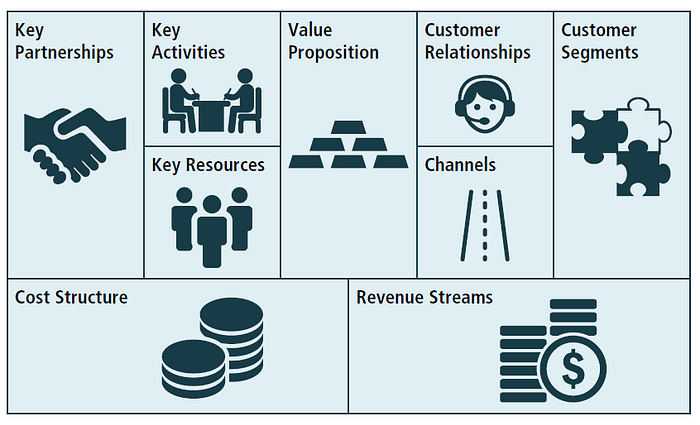Unlocking Business Insights with the Business Model Canvas
Written on
Understanding the Business Model Canvas
Why did Business Analysts bring the Business Model Canvas (BMC) to the gathering? Was it to introduce some strategic flair to the festivities? — Erivan Ramos
Welcome! This is the third technique in our series on Business Analysis Techniques. Previously, we discussed Decision Analysis and Backlog Management.
The Business Model Canvas serves as a strategic management tool that aids in visualizing and comprehending a business idea in a straightforward and structured format. It can be employed to design, assess, and refine business models.
Here's an illustration of the Business Model Canvas:

Nine Key Components of the Business Model Canvas
The Business Model Canvas is comprised of nine essential components, each contributing to a comprehensive view of a business:
Value Proposition
This fundamental element outlines the value the business offers. It addresses how the business resolves customer issues, meets their needs, and distinguishes its solutions from competitors.
Customer Segments
This segment defines the target customers, their needs, preferences, and behaviors, as well as how to categorize them into distinct groups.
Channels
This section explores how to reach customers, detailing the various methods of communication, delivery, and sales of value propositions—whether through physical stores, online platforms, social media, or other means.
Customer Relationships
Here, the focus is on the types of relationships built with customers, detailing strategies for attracting, retaining, and expanding the customer base, including fostering loyalty.
Revenue Streams
This aspect identifies the different income sources generated from customers, discussing what customers are willing to pay and the frequency and amount of these payments.
Key Resources
This includes the essential assets required to deliver value propositions, encompassing physical, intellectual, human, and financial resources.
Key Activities
This section outlines the crucial actions the business must undertake to deliver its value proposition, such as production and problem-solving activities.
Key Partnerships
This component highlights the external entities that collaborate with the business, including suppliers, distributors, and strategic allies that support value creation.
Cost Structure
This includes the major costs incurred to deliver the value proposition, detailing both fixed and variable expenses.
Uses of the Business Model Canvas
The Business Model Canvas serves multiple purposes, including:
- Developing new business concepts or refining existing ones.
- Analyzing strengths, weaknesses, opportunities, and threats of a business model.
- Comparing various business models or scenarios.
- Communicating and presenting a business model to stakeholders.
- Aligning and collaborating with team members or partners.
- Clarifying value propositions and target markets.
- Evaluating competitive advantages and risks.
- Analyzing revenue streams and cost structures.
Benefits of Implementing the Business Model Canvas
The BMC is a practical tool for business analysts, offering several advantages:
- It provides a concise overview of essential business model elements on a single page.
- It emphasizes critical aspects such as Value Proposition and Customer Segments, avoiding unnecessary complexity.
- It allows for easy comparison of different business models or scenarios.
- It enhances communication among team members and stakeholders through a shared visual framework.
- It fosters creativity and innovation by encouraging experimentation.
Challenges of the Business Model Canvas
Despite its strengths, the Business Model Canvas has limitations:
- It may lack depth in certain areas, such as market size and competitive advantages.
- It does not capture the dynamic nature of business models over time.
- It may require iterations and does not offer a clear sequential process for development.
- It overlooks emotional and psychological factors like customer satisfaction and brand loyalty.
- It can be influenced by assumptions rather than factual data.
To mitigate these limitations, the Business Model Canvas can be supplemented with other analysis tools, such as:
- Value Proposition Canvas: Focuses on designing value propositions tailored to specific customer segments.
- Lean Canvas: Validates business models for startups by emphasizing problems and unique value propositions.
- SWOT Analysis: Assesses internal and external factors affecting business models.
- PESTEL Analysis: Evaluates political, economic, social, technological, environmental, and legal impacts on business models.
Real-World Applications of the Business Model Canvas
The BMC is versatile and applicable to various businesses, from startups to established companies. Here are examples of its use by notable companies:
Airbnb
Airbnb connects property owners with travelers seeking accommodation, exemplifying the sharing economy.
Spotify
As a music streaming service, Spotify showcases its dual revenue model through subscriptions and advertising.
Conclusion
The Business Model Canvas is an invaluable technique for business analysts, enabling them to create and communicate business models effectively. While it serves as a foundational tool for exploration, it is essential to complement it with detailed business plans and market research for a complete understanding of a business model.
Stay tuned for more insights on Business Analysis Techniques. We welcome your thoughts in the comments and invite you to subscribe for more articles!